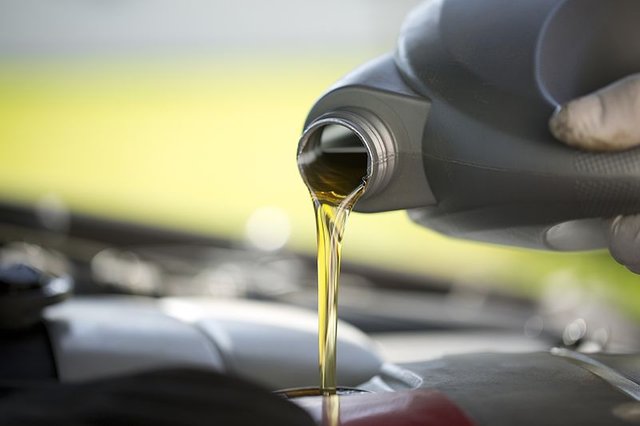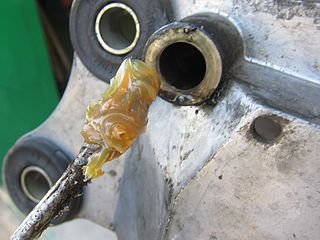Journal Bearing Lubrication: An Introduction to the "Oil of Life"
Hi fellas, how’re you doing today? Welcome once again to my blog. As usual, I appreciate your support and contributions so far.
It’s no news that it has been intense in one way or the other in the @steemstem community about how poor we engage with ourselves. I particularly got emotional reading the texts from @justTryMe90 @lemouth @mobbs and @suesa the other night on discord. So, after @kryzsec @lets-tech @churchboy @alexdory and many others have put in lotta efforts with one suggestion or the other, I felt its time I brought forth my contributions.
As a Nigerian, we are known to be quite religious and I thought to reach out to a cleric for some solution could help (lol..I know it’s crazy). Wondering what I got? I was given an all-rounder antidote - it’s called the OIL OF LIFE. Do we have any Nigerian Celestial Christian here? They would relate more.
OIL OF LIFE would help smoothen the member relationships, remove any wear or tear and help us move faster. Wait, is this even a science post? Well, it is! Just stay here as I break it down to a more relatable bulk of words.
In my previous post here, I explained the concept of Journal Bearing where I stated that their functioning depends on three major elements; the Bearing, Journal (or shaft) and the interposed Lubricant. The Lubricant was said to be the main element that allows it function well. It keeps away contact between the mating parts as it is interposed in the clearance between the bearing and the Journal.
So, we can agree that the Lubricant in the Journal Bearing works in the same way the OIL OF LIFE will do for us. They both help in smoothening, removing wear or tear and help members move faster.
So, let’s pause the obvious joke for something more serious (if you believe me). Let’s learn about Lubrication in Journal Bearing together.

WHAT IS LUBRICATION?
Lubrication is simply a technique used in reducing friction between two surfaces in contact by interposing a lubricant in between them. This lubricant can be a solid, liquid or in some cases, gas.
Have I told us what friction is? Don’t we know it? Well, for the sake of the geniuses here, I’ll like to give a simple definition of it. Friction is just the force or resistance that is witnessed when two surface moves against each other. This in many ways has proved helpful in our day to day life, especially in making our cars drivable on roads. It is the friction that exists between the tire surface and the ground that makes it possible to move cars.
As nice as Friction poses itself though, it is a green snake under the grass. In fact, it is a devil – to our machines though. Especially in the operation of machinery, friction causes increase wear of the contacting elements and reduces the efficiency of the components.
This arising situation calls for friction to be eliminated or at least minimized. According to Zargari (2007), an effective way to reduce wear and friction is by interposing an appropriate lubricant between the surfaces in contact and hence emphasizes the need for lubrication.
In Journal Bearing – a type of Fluid Bearing, lubrication is the main characteristics governing its operation and it functions as a load bearing film, helps dissipate frictional heat (thus preventing overheating), reduces deterioration of the lubricants, and provides protection from corrosion, moisture, and the introduction of contaminants.
TYPES OF LUBRICATION
Lubrication is an important phenomenon that is required for correct operation of mechanical systems such as bearings, pistons, pumps, cams, and so on. Without it, the friction pressure that builds up between surfaces having direct contact could generate enough heat to cause a seizure in the system. There are five common types of Lubrication; these are:
- Hydrodynamic lubrication
- Hydrostatic lubrication
- Elastohydrostatic lubrication
- Boundary lubrication
- Solid lubrication
The Hydrodynamic Lubrication is known as the Full Film Lubrication. Here, the two mating surfaces (say metals) are completely separated by a thick film of lubricant that there is no metal to metal contact existing. This can be seen in the Hydrodynamic journal bearing explained in my previous post.
The Hydrostatic type of Lubrication is characterized by the supply the lubricant into the clearance in a pressurized manner from an external source. The lubricant is pressurized enough to separate metal to metal contact. Just like Hydrodynamic Lubrication, it is also a full film type of lubrication.
Elastro-hydrostatic lubrication involves supplying lubricant at a pressurized state from an external source as in the Hydrostatic lubrication. But unlike in hydrostatic lubrication, it exists between rolling elements rather than rotating surfaces.
Boundary lubrication is known as Thin Film Lubrication. It exists in conditions where full fluid lubrication cannot be achieved like during start-up or in a very low-speed application. Here, the film is usually very thin that there could exist metal to metal contact. It is used in cases where the lubricant viscosity is low, relatively high load or low speed of the shaft.
Solid lubrication as the name implies involves interposing of solid lubricants such as graphite, molybdenum sulfide and so on between mating surfaces. This is usually employed when there is machine operation at an extreme temperature where fluid lubrication isn’t applicable.
Journal Bearing majorly operates between Hydrodynamic, Hydrostatic and Boundary Lubrication regime. Generally, the hydrostatic Lubrication occurs during machine operation.
CHOOSING A LUBRICANT FOR MACHINE APPLICATIONS
The process of choosing a lubricant for mechanical and industrial systems is a critical process as it must take into account the functional conditions of the lubricating mechanism as well as the expected working temperature, the applied pressure force, the relative velocity and the environmental conditions. This puts us in the position of finding the correct lubricant that would fit in the profile and work efficiently. For lubrication of most mechanical systems, Oil and Grease are the most common lubricants usually used.
For Journal Bearings, Oil is preferred in cases where cooling and flushing of wear debris (or any contaminant) are the predominant factors. They are the most commonly applied lubricants especially because they are preferred for high- speed applications which are the trend in modern industries.Grease for its thickness is usually applied for applications where there is usually shock loads and high vibration. It helps to absorb such sudden loads and resulting vibration. It is used when cooling or flushing of wear debris isn’t predominant.
METHODS OF APPLICATION OF LUBRICATION
In applying lubrication to machines, there are different methods to actualize that. It could be a self-lubrication or externally supplied lubrication. But in getting the lubricant in or out of the machine, this could be done in four different ways. It is either by
- The Oil drip feed lubrication method
- The Oil splash lubrication method
- The Oil force lubrication method
- Grease lubrication method.
ADVANCES IN LUBRICATION SCIENCE
As a vital field devoted to high-quality research in science and technology related to lubrication of machine, it has been an attractive and interesting filed for researchers. Over the years, many researchers have contributed to the advances in lubrication research and development.
From Numerical analysis to analytical analysis of lubricant flow in members, we have also seen the development of knowledge in the micro and Nano-lubrication field. Computer fluid dynamics (CFD) analysis are now also seeing growing interest and the field keeps growing.
CONCLUSION
At every point in our lives, we must always try to be conscious of the effect of maintaining a smooth relationship through engagements, networking, and avoidance of discouraging antics. We should learn to find a way to remove any kind of friction that might arise in deterioration and hence, wear and tear within us.
Here, the Lubricant is the soul of a good and safe machine operation as it helps to ensure smooth movement and removal of wear debris and contaminants from the system. It helps ensure a longer lifespan of the machine and enhances efficient operation.
So, as recommended and implored, let’s be friends, family, and colleagues, watching out for one another and constantly showing love for ourselves.
And not to forget, don’t make me need to consult a cleric for any kind of OIL OF LIFE. We are the oil, let’s lubricate ourselves.
Thanks for reading.
REFERENCES
- Malcolm, E. and Leader P. (2001). “Understanding Journal Bearings”, Applied Machinery Dynamics Co., Durango, Colarado, pp 1-26
- Zagari, A. (2007). “Computational Analysis of Integral and Differential Formulations of the Elastrohydrodynamic Lubrication Film Thickness Equation”
- Machinery Lubrication
- Bright HUb Engr: Lubrication
- Mobility Work: Lubrication
- Tech Transfer: Oil and Grease Application Methods
If you write STEM (Science, Technology, Engineering, and Mathematics) related posts, consider joining #steemSTEM on steemit chat or discord here. If you are from Nigeria, you may want to include the #stemng tag in your post. You can visit this blog by @stemng for more details. You can also check this blog post by @steemstem here and this guidelines here for help on how to be a member of @steemstem. Please also check this blog post from @steemstem on proper use of images devoid of copyright issues here.



THE OIL OF LIFE!
thats a take-home for me
Every mechanism that involves the relative movement of two surfaces against one another definitely requires the lubrication else, the life span is sure to be short.
nice intro sir.
cheers!
Definitely, the life span suffers!
thanks for the kind comments....I appreciate your kind gesture
always welcome!
You have said so much @mrbreeziewrites and none of your words is far from the fact. I love the way you used lubrication as an analogy for the current situation in the @steemstem community. Good article sir!
I hope with the latest developments everyone will come to realize what we stand to gain if we stick together.
Thanks for the compliments.
Yes, I hope so. The community stood for us, it is our time to stand as tall too.
Thanks for stopping by
Good work. I just have a question. My new engine was short of oil, and not due for service. Can I add oil to complement it?
Changing oil could be a critical thing to do. Make sure you check manual for information on the interval of a change. However, when the oil level has dropped below the minimum, it is advisable that you top it
Nice work...Good relation of words! Kudos
Thanks sire
I'd need some lubrication to my knees, it's so creaky due to lack of use :)
Hahahaha. Lack of use? Don't tell me you don't work those legs on weekend at least..
But, I wouldn't lubricate it with my grease or oil, the synovial fluid should do justice to that.
Thanks for stopping by sire
Pun intended?
Pure intent sir (laughs)...... #maybe
I like the tone of this piece of writing. Bringing humor into STEM posts will spice things up especially engagement.
Yeah, thank God for the @steemstem break.. It birthed something
Thanks for stopping by
Congratulations! This post has been upvoted from the communal account, @minnowsupport, by Mrbreeziewrites from the Minnow Support Project. It's a witness project run by aggroed, ausbitbank, teamsteem, theprophet0, someguy123, neoxian, followbtcnews, and netuoso. The goal is to help Steemit grow by supporting Minnows. Please find us at the Peace, Abundance, and Liberty Network (PALnet) Discord Channel. It's a completely public and open space to all members of the Steemit community who voluntarily choose to be there.
If you would like to delegate to the Minnow Support Project you can do so by clicking on the following links: 50SP, 100SP, 250SP, 500SP, 1000SP, 5000SP.
Be sure to leave at least 50SP undelegated on your account.